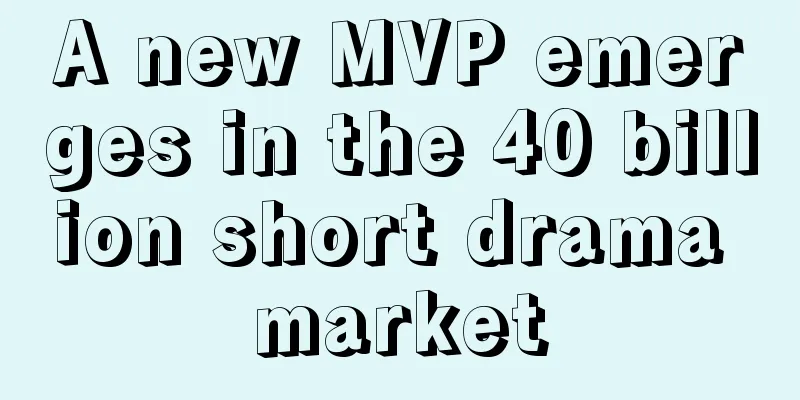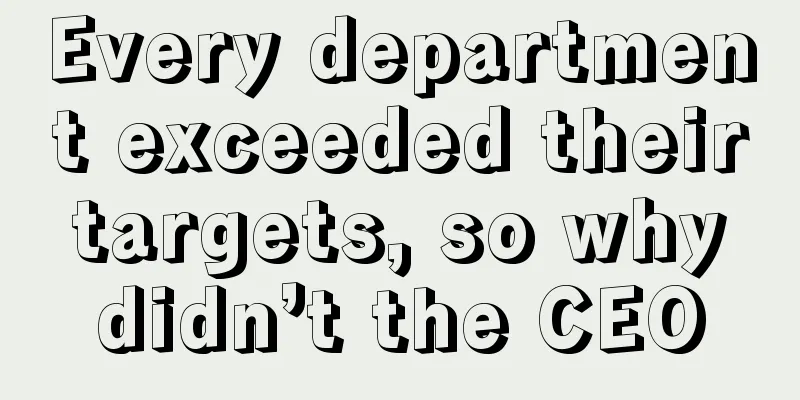This is how annual targets should be set, not by guesswork.

At the end of the year, many companies are setting goals for the next year. In the process of setting goals, data analysts will participate to varying degrees. This is another headache. After working hard on a version, the leader often overturns it with a sentence like "Think about it again" or "This is how I see it". We are also often asked to use scientific and reasonable methods to prove that the leader's decision is correct... It makes newcomers miserable. Today, we will systematically explain how to achieve the annual task goals. 1. Difficulties in setting annual goalsThe reason why annual goals are difficult to achieve is the core of the conflict of interests between superiors and subordinates. Often: 1. Leaders want to set high targets, but subordinates think they cannot be completed, so they find all kinds of excuses to shirk their responsibilities. 2. If the lower-level departments want to gain merit, they will try their best to build monuments for themselves. But if the leaders disagree, they will suppress them in various ways. 3. The new leader is not familiar with the situation, so he throws the blame for setting the goals away and waits to see who will take the brunt of the situation. In short, it is troublesome when the butt decides the head. When the head is in charge, everyone hopes for an objective and fair analysis to point out the direction. When the butt is in charge, everyone starts to attack the analysis results and will not stop until they achieve their goals. Data analysis happens to be easily caught between departments. That is why it is difficult to do. What to do? 2. Basic ideas for setting annual goalsSome students simply gave up resistance and laid down to be whored: "Whatever the boss says is fine, as long as you are happy, whatever you like is fine." The last time I heard this was when I saw the male protagonist in a costume drama visiting a brothel... As a professional data person, you must not give up resistance directly, otherwise you will not only lose your professionalism, but also leave a huge pit for the subsequent disassembly task. When you are forced to use scientific methods to prove the goals that leaders have come up with on a whim, you have to shed a layer of skin. The key to solving the problem is to eliminate external factors and subjective factors that are uncontrollable, immeasurable, and incalculable. State the objective facts clearly. List the possible objections one by one, and use data to support or deny them. In this way, the role of data can be maximized, at least providing a relatively objective basic data. As for the rest of the bickering between departments and between superiors and subordinates, let them fight it out on their own (as shown in the picture below). How to do it? Check it out now 3. Example of making annual goalsFirst of all, the annual goals must be agreed upon with the leaders and colleagues in various departments before they can be confirmed. So don’t think about using algorithmic models to do it. The process is too complicated and cannot be linked to business actions, and you will definitely be criticized. At this time, you can use the hypothesis deduction method to add internal and external influencing factors based on past business trends. ▌Step 1: Review past business trends to determine next year’s tone for example: ● As shown in the following figure, case 1, the business itself is in the life cycle ● As shown in the following figure, case 2, the business itself has seasonal fluctuations and is in an upward period ● As shown in the following figure, case 3, the business itself is affected by the investment and has explosive growth With the basic trend, we can set the tone for next year: expected rise, stability, or decline. And this step is supported by past data and will not be attacked by others. ▌Step 2: Add internal control factors and modify the basic trend. Both internal and external factors will affect the performance trend. When considering them, give priority to internal and controllable factors. Because external factors are difficult to quantify and uncontrollable, it is easy to fall into a metaphysical war if you start with external factors. When examining internal factors, there are also priorities: ● Level 1: Consider the leaders’ positioning of business development: expansion, conservatism, contraction ● Level 2: Consider business capital and human resources input: increase, remain the same, unchanged ● Level 3: Consider changes in technology, solutions, and capabilities of business departments. Revise next year's trend based on the above three points. The first thing to consider is positioning, because it is the biggest indicator. If the management has given up on the development of a business, then the subsequent resources, technology, and manpower will definitely not continue to be invested. Therefore, the performance in the indicators is that the trend of the bad is getting worse. If you still want to continue to develop, you may invest more resources, and the situation will be even better (as shown in the figure below). The second thing to consider is input-output, because this is the focus of annual goal setting. What the business fears is not high goals, but high goals without resources. Just shouting to go to the battlefield to kill the enemy, but not giving guns and bullets, what can we do? Therefore, this is the key to setting goals. If the required target and the planned investment grow in the same proportion, it will be much easier to set the target. You only need to double the past trend in proportion (or increase the ROI slightly) based on the growth rate. If leaders ask data analysts to predict next year's target, they can also make a prediction based on the unchanged input-output ratio, and then wait for everyone to find fault (as shown in the figure below). This is valid as long as there is no sign of declining ROI or diminishing marginal returns. If such signs appear, management and business departments should be reminded that great efforts may not necessarily produce miracles, and technology upgrades/method updates should be considered. What’s even worse is that the growth rate expected by the leader is much higher than the growth of investment. This will lead to verbal battles between departments and between superiors and subordinates. As a data analyst, you don’t need to personally participate in the fight. Instead, you can provide objective data for everyone’s reference. At this time, you can list the ROI of each month in the past to let everyone see that the ROI expected by the leader is all, part, and occasionally exceeds the overall level (as shown in the figure below). As for whether the business can change its fate and whether it can magnify its advantages, that is a question they have to think about. At this time, the question of whether the data forecast is accurate has been successfully transformed into the question of whether the business has the ability to do well. Data can only assess objective conditions, but cannot measure people's subjective initiative in advance. At this time, data analysts can watch the quarrels between business departments and wait to hear the conclusions to revise the data. With the first two steps, the discussion of the third step is a natural outcome. In fact, the business department rarely accepts the approach of "the boss doesn't invest, so I come up with super awesome technology to turn things around." Therefore, the discussion in the second step is the key. After completing the second step, the annual goal has taken a basic form (as shown below). ▌Step 3: Consider external factors and adjust the performance trend line. Unless there are earth-shaking changes in the regulatory policies and overall trends facing the industry, internal control factors will be given priority. External factors are more of a reference for verbal battles. for example: 1. Weak industry growth: Market capacity data needs to be collected 2. The opponent has made a major move: need insider information + the performance trend of the opponent 3. Major changes in policies and regulations: need gossip + observation of past policy effects In short, the above factors are difficult to quantify directly, so it depends more on whether there is real data to support them and whether additional contingency plans should be prepared. When doing routine mission objectives, internal factors should still be the main focus. But what’s interesting is that in this year’s environment, the external link is a major issue! The decline in social consumption power, industry involution and other problems are so obvious that the trend lines of many industries may be different from history. IV. SummaryThe annual task goal is itself a process of consensus among all departments, so data is more meaningful as a reference. Sufficient space needs to be left for discussion between departments, and problems and topics need to be clearly listed. If leaders ask us to put aside business considerations and predict the possible natural growth in the future, we can make a model to predict it as a benchmark. In short, the method follows the purpose, and the one that is suitable for the current business scenario is the best method. |
<<: The reasons and solutions for the second phase of the interruption of Pinduoduo's through train
>>: "Control" Baoma, why does this brand continue to dominate the Douyin charts
Recommend
How to quickly break zero on Shopee? Tips to quickly break zero on Shopee
After merchants settle in an e-commerce platform, ...
Southeast Asian e-commerce is in a slump, and TikTok sellers are running with it
Southeast Asia's e-commerce market will become...
What are the top ten import cross-border e-commerce platforms?
In the cross-border e-commerce industry, most merc...
Why I chose to leave the workplace in 2023
This article explores the thinking and considerati...
Some thoughts for April 2023!
Introduction: This article is the author’s persona...
What happens if I don't pay the eBay fee? Does eBay charge a fee?
The entry threshold of eBay platform is low, but i...
"Escape from the British Museum", how did it become so popular?
Recently, "Escape from the British Museum&quo...
Shopee will suspend logistics incentives for sellers in non-free pickup areas from October
Shopee platform launched a logistics incentive pla...
In this environment, how can we demonstrate the value of data analysis?
How to reflect the value of data analysis in a sce...
How to build a complete user analysis system?
How to create a user analysis system? Let's le...
100 keywords predicted for 2024 | Technological innovation (11-20): new identity, empathy technology, odor digitization, human-machine symbiosis
What will be the key words for development in 2024...
Some practical suggestions for Xiaohongshu placement
This article points out that seeding requires a lo...
What are the seven major scams in cross-border e-commerce? How to prevent them?
I believe that many friends now prefer cross-borde...
With private domain revenue exceeding 100 million yuan in half a year, how does Winona, the "pride of domestic products", use private domain to achieve performance growth?
Do you know Winona? How did it achieve rapid devel...
August overseas hot marketing calendar: seize these 7 nodes and let your products take off!
For e-commerce, games, interactive entertainment, ...









